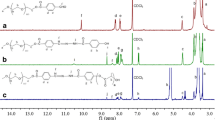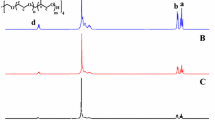Abstract
In this paper, we report the synthesis and self-assembly of double-hydrophilic hyperbranched graft copolymers of HPG-g-PDMAEMA, which consist of a hyperbranched polyglycerol (HPG) core and several grafted poly(2-(dimethylamino)ethyl methacrylate) (PDMAEMA) arms. HPG was synthesized by cationic polymerization. Then HPG-Br macroinitiator was obtained by esterification of HPG with 2-bromoisobutyryl bromide, which was subsequently used in the preparation of HPG-g-PDMAEMA graft copolymers through atom transfer radical polymerization (ATRP) of DMAEMA monomers. The molecular structures were studied by 1H NMR and GPC. The pyrene-based fluorescent probe method, 1H NMR and DLS were used to study the self-assembly behavior of HPG-g-PDMAEMA. The drug loading and pH-responsive release properties of HPG-g-PDMAEMA were also investigated by using coumarin 102 as a model drug. The results show that the HPG-g-PDMAEMA micelles can continuously release and re-encapsulate coumarin 102 as the pH continuously changes from 11.5 to 2.5; however, this process is not totally reversible.
Similar content being viewed by others
References
Cölfen H. Double-hydrophilic block copolymers: synthesis and application as novel surfactants and crystal growth modifiers. Macromol Rapid Commun, 2001, 22: 219–252
Kabanov A V, Kabanov V A. Interpolyelectrolyte and block ionomer complexes for gene delivery: Physico-chemical aspects. Adv Drug Deliv Rev, 1998, 30: 49–60
Cölfen H, Antonietti M. Crystal design of calcium carbonate microparticles using double-hydrophilic block copolymers. Langmuir, 1998, 14: 582–589
Qi L, Li J, Ma J. Biomimetic morphogenesis of calcium carbonate in mixed solutions for surfactants and double-hydrophilic block copolymers. Adv Mater, 2002, 14: 300–303
Martin T J, Prochazka K, Munk P, Webber S E. pH-dependent micellization of poly(2-vinylpyridine)-block-poly(ethylene oxide). Macromolecules, 1996, 29: 6071–6073
Butun V, Billingham N C, Armes S P. Unusual aggregation behavior of a novel tertiary amine methacrylate-based diblock copolymer: Formation of Micelles and reverse Micelles in aqueous solution. J Am Chem Soc, 1998, 120: 11818–11819
Liu S, Armes S P. Polymeric surfactants for the new millennium: A pH-responsive, zwitterionic, schizophrenic diblock copolymer. Angew Chem Int Ed, 2002, 41: 1413–1416
Liu S, Billingham N C, Armes S P. A schizophrenic water-soluble diblock copolymer. Angew Chem int Ed, 2001, 40: 2328–2331
Cai Y, Armes S P. A zwitterionic ABC triblock copolymer that forms a “trinity” of micellar aggregates in aqueous solution. Macromolecules, 2004, 37: 7116–7122
Gao C, Tang W, Yan D, Zhu P, Tao P. Hyperbranched copolymers made from A2, B2 and BB’2 type monomers (iv) — Copolymerization of divinyl sulfonate with 4, 4′-trimethylenepiperidine and N-ethylethylenediamine. Sci China Ser B, 2001, 44: 207–215
Zhu X, Chen L, Chen Y, Yan D. Using 2D NMR to determine the degree of branching of complicated hyperbranched polymers. Sci China Ser B. 2008, 51: 1057–1065
Wurm F, Nieberle J, Frey H. Double-Hydrophilic Linear-Hyper-branched Block Copolymers Based on Poly(ethylene oxide) and Poly(glycerol). Macromolecules, 2008, 41: 1184–1188
Ranganathan K, Deng R, Kainthan R K, Wu C, Brooks D E, Kizhakkedathu J N. Synthesis of thermoresponsive mixed arm star polymers by combination of RAFT and ATRP from a multifunctional core and its self-assembly in water. Macromolecules, 2008, 41: 4226–4234
Tokar R, Kubisa P, Penczek S, Dworak A. Cationic polymerization of glycidol: coexistence of the activatedmonomer and active chain end mechanism. Macromolecules, 1994, 27: 320–322
Sunder A, Hanselmann R, Frey H, Mulhaupt R. Controlled synthesis of hyperbranched polyglycerols by ring-opening multibranching polymerization. Macromolecules, 1999, 32: 4240–4246
Wang S, Chen H, Zhou Y, Yan D. Synthesis and self-assembly of alkyl esterified hyperbranched polyglycerols. J Funct Polym, 2008, 21: 128–132
Lee H, Wu W, Oh J K, Mueller L, Sherwood G, Peteanu L, Kowalewski T, Matyjaszewski K. Light-induced reversible formation of polymeric micelles. Angew Chem Int Ed, 2007, 46: 2453–2457
Dai S, Ravi P, Tan C H, Tam K C. Self-assembly behavior of a stimuli-responsive water-soluble [60]fullerene-containing polymer. Langmuir, 2004, 20: 8569–8575
Muñoz-Bonilla A, Fernández-García M, Haddleton D M. Synthesis and aqueous solution properties of stimuli-responsive triblock copolymers. Soft Matter, 2007, 3: 725–731
Astafieva I, Zhong X F, Eisenberg A. Critical micellization phenomena in block polyelectrolyte solutions. Macromolecules, 1993, 26: 7339–7352
Kabanov A V, Nazarova I R, Astafieva I V, Batrakova E V, Alakhov V Yu, Yaroslavov A A, Kabanov V A. Micelle formation and solubilization of fluorescent probes in poly(oxyethylene-b-oxypropylene-b-oxyethylene) solutions. Macromolecules, 1995, 28: 2303–2314
Zhao C L, Winnik M A, Riess G, Croucher M D. Fluorescence probe techniques used to study micelle formation in water-soluble block copolymers. Langmuir, 1990, 6: 514–516
Astafieva I, Khougaz K, Eisenberg A. Fluorescence study of the critical micelle concentration as a function of soluble block length and salt concentration. Macromolecules, 1995, 28: 7127–7134
Gohy J F, Creutz S, Garcia M, Mahltig B, Stamm M, Jérôme R. Aggregates formed by amphoteric diblock copolymers in water. Macromolecules, 2000, 33: 6378–6387
Mai Y, Zhou Y F, Yan D Y. Synthesis and size-controllable self-assembly of a novel amphiphilic hyperbranched multiarm copolyether. Macromolecules, 2005, 38: 8679–8686
Hong H, Mai Y, Zhou Y F, Yan D Y, Cui J. Self-assembly of large multimolecular micelles from hyperbranched star copolymers. Macromol Rapid Commun, 2007, 28: 591–596
Author information
Authors and Affiliations
Corresponding authors
Additional information
Supported by the National Natural Science Foundation of China (Grant Nos. 20774057 & 50633010), National Basic Research Program (973 Project, Grant No. 2007CB808000), the Basic Research Foundation of Shanghai Science and Technique Committee (Grant No. 07DJ14004), and the Shanghai Leading Academic Discipline Project (Grant No. B202)
Rights and permissions
About this article
Cite this article
Sun, X., Zhou, Y. & Yan, D. Drug release property of a pH-responsive double-hydrophilic hyperbranched graft copolymer. Sci. China Ser. B-Chem. 52, 1703–1710 (2009). https://doi.org/10.1007/s11426-009-0227-4
Received:
Accepted:
Published:
Issue Date:
DOI: https://doi.org/10.1007/s11426-009-0227-4




